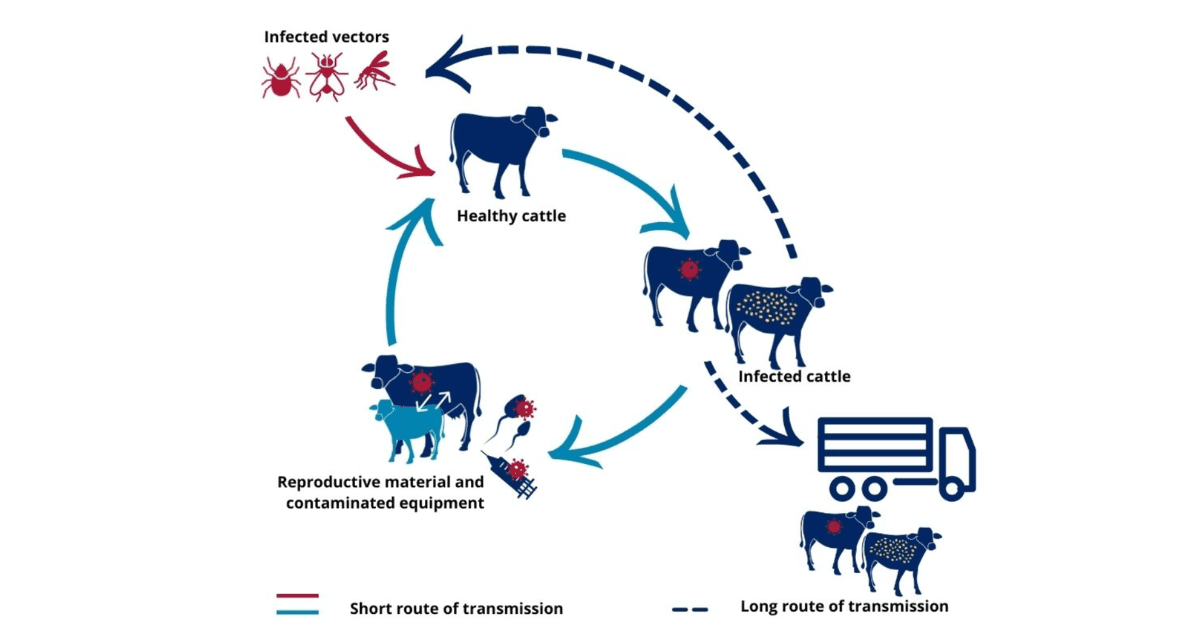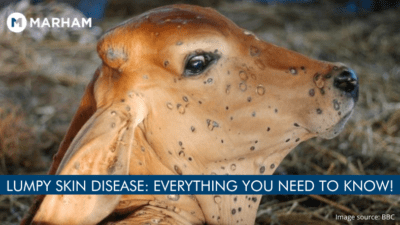Lumpy skin disease is a new viral illness that is spreading quickly throughout Pakistan. It is a serious disease that can cause death in cattle, particularly young calves. The recent increase in the number of cattle affected by this disease has left farmers devasted.
After the COVID-19 pandemic, we must be aware of any new potential disease that can be a cause of concern. This health blog explains everything related to lumpy skin disease and if it is contagious to humans or not.
“The economic consequences of the lumpy skin disease pandemic are projected to affect five million dairy and meat producers,” says a report from May 2022.
What is lumpy skin disease?
Lumpy skin disease is a viral infection that mostly affects cattle. It is spread by blood-feeding insects such as flies and mosquitoes, as well as ticks.
Many African countries have had lumpy skin disease. It moved from the Middle East to southeast Europe in 2012, hitting Greece and Bulgaria as well as numerous other Balkan nations. Now, it seems to be spreading in Asian countries like Pakistan.
The lumpy skin disease virus is highly stable. It can last for extended durations at room temperature, particularly in dry scabs. LSDV can live in necrotic skin nodules for up to 33 days or more, desiccated crusts for up to 35 days, and air-dried hides for at least 18 days.
It causes fever, nodules on the skin, and death, particularly in animals that have never been exposed to the virus. Vaccinations and culling of affected animals are two approaches for control.
Lumpy skin disease symptoms:
The lumpy skin disease in cattle or cows is characterized by:
- Fever over 41 degrees Celsius
- skin lesions, or lumps, that can occur anywhere on the body
- lumps are usually firm and raised
- reduction in milk production
- they may be black, red, or yellow in color
- lumps can occur singly or in groups, and they may be painful or itchy
- Scabs form in the center of the nodules and fall off, leaving big holes that can get infected
- swelling of the limbs, chest, and genitals
- Watery eyes
- Nasal and salivary secretions
The virus that causes the disease can also infect humans, although this is rare. Symptoms in humans include:
- fever
- headache
- a rash
If you have any of these symptoms, it is best to consult with a doctor. Click here to see an Online Doctor today via the Marham app.
What is the cause of lumpy skin disease?
Lumpy Skin Disease is caused by the Capripoxvirus virus that shares genetic similarities with the goatpox and sheeppox virus families.
The virus is known to spread by direct contact with infected animals or by contact with contaminated materials, such as water troughs or pastures. The disease can also be spread by biting insects, such as flies.
How does lumpy virus spread?
Scientists are still not sure about how the lumpy skin disease spreads. The two primary transmission methods known till now are:
- by arthropod vectors: such as mosquitoes, ticks, and biting flies
- movement of infected animals
Fomites can also transfer the disease through contaminated equipment and, in certain situations, directly from animal to animal. The illness has demonstrated its potential to develop and spread in a broad variety of environmental and industrial settings worldwide.


Is lumpy skin disease contagious to humans?
Lumpy skin disease is a highly contagious disease that affects cattle. However, this disease is not a threat to humans. The Agha Khan University Hospital has declared that this doesn’t cause human disease in March 2022.
But still, LSD is a serious problem for the cattle industry, as it can lead to significant economic losses due to decreased milk production and animal death.
Lumpy Skin Disease Diagnosis:
According to a study, lumpy skin disease can be diagnosed using the following methods of agent identification:
- PCR: Polymerase chain reaction (PCR) is the simplest and least costly technique for detecting LSDV. Skin nodules and scabs, saliva, nasal secretions, and blood are all acceptable PCR samples.
- Viral isolation (VI): It is followed by PCR to confirm virus identification, takes longer, and costs more. However, it offers the benefit of showing the presence of a living virus in the sample.
- Electron microscopy: It can identify the typical poxvirus virion but cannot discriminate between them.
Also, read about the Lumpy Skin Disease in Urdu.
Lumpy skin disease Treatment:
Early diagnosis and treatment of LSD are essential to control the disease and minimize losses. There are two main ways to treat LSD:
- Vaccination: “Currently, most commercially available vaccines against LSD are live attenuated vaccines based on an LSDV strain, sheeppox virus (SPPV), or goatpox virus (GTPV),” says research.
- Treatment of symptoms: Secondary skin infections can be managed with nonsteroidal anti-inflammatory drugs (NSAIDs) and antibiotics as necessary.
Vaccination is the most effective method of LSD control and prevention. However, treatment of symptoms is also important to relieve the animal’s discomfort.
How do you prevent lumpy skin?
Evidence from the present LSD pandemic in Europe and Western Asia shows that early discovery of the index case, followed by a swift and extensive immunization program, is critical to successful LSD control and eradication.
According to Nadis Animal Health Skills, Lumpy skin disease is controlled and prevented using four measures:
- movement restriction (quarantine)
- vaccination
- slaughter campaigns
- management strategies
Specific national control strategies differ by country, thus guidance from appropriate authorities and veterinarians is recommended.
The Bottom Line
Lumpy skin disease virus is a severe problem for cattle that causes huge losses and has serious economic repercussions.
It also prevents affected nations from accessing lucrative export markets, exacerbating the financial cost of an LSD pandemic. There is no cure for the disease but it can be prevented through LSD vaccines.
While there is a low risk of getting infected with lumpy skin disease in humans, it is better to be cautious. If you notice any symptoms see a doctor as early as possible.
Can’t Find the App?
| Android | IOS |
|---|---|
  |
  |
FAQs
Can lumpy skin disease be cured?
Currently, no particular antiviral medications are available to treat lumpy skin conditions. Cattle supportive care is the primary available therapy. This might involve utilizing wound care sprays to treat skin lesions and medications to avoid additional skin infections and pneumonia.
How long does lumpy skin disease take to heal?
It may take up to six months for animals seriously infected by the lumpy skin disease virus to fully recover. Especially when recurrent bacterial infections develop, complete healing may take many months. The treatment aims to stop or control recurrent infection.
What is the incubation period of lumpy skin disease?
Under laboratory settings, the incubation time after viral injection of lumpy skin disease ranges between 4 and 14 days. It can be diagnosed by histopathology, virus isolation, or PCR.

